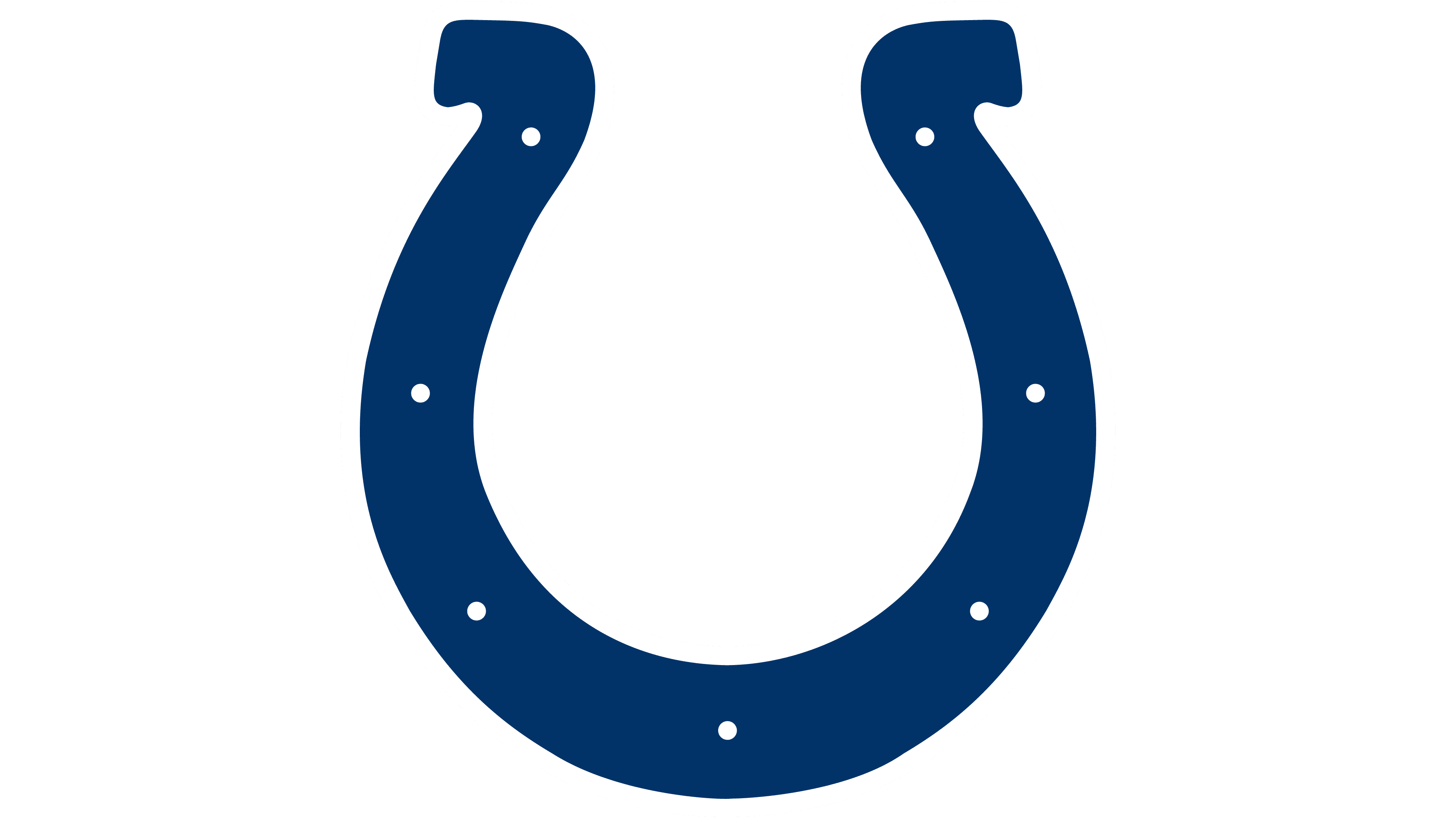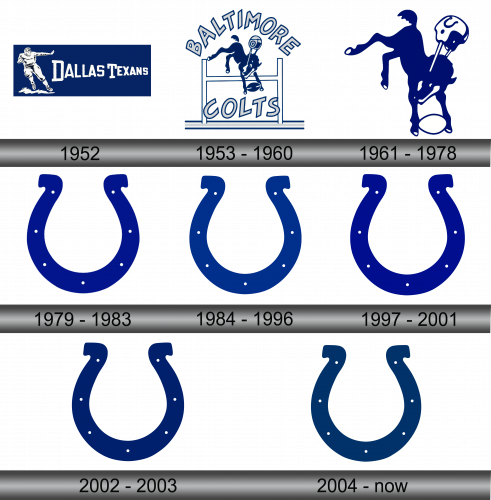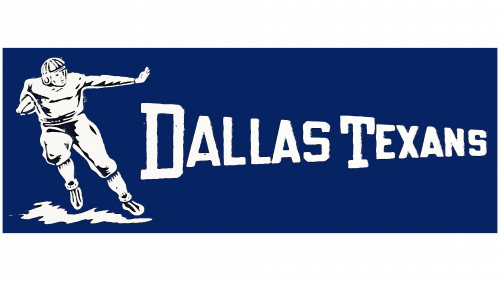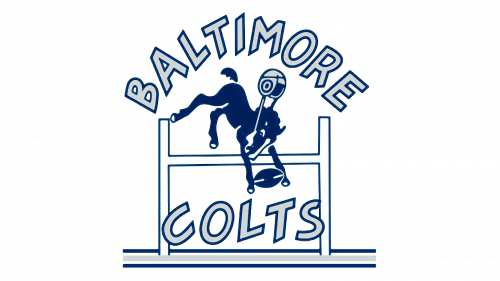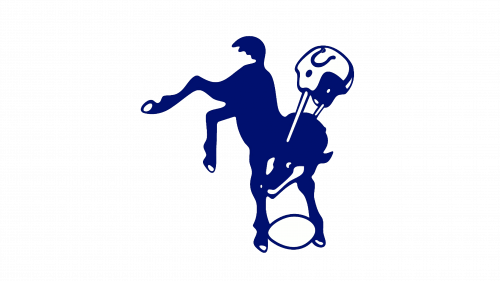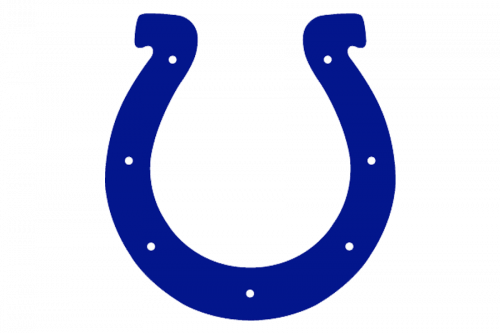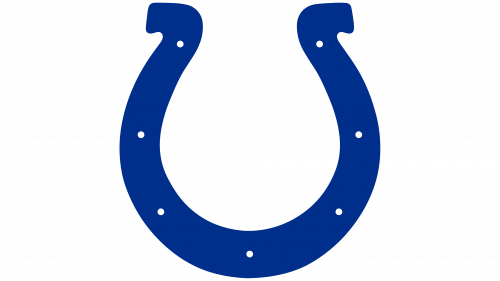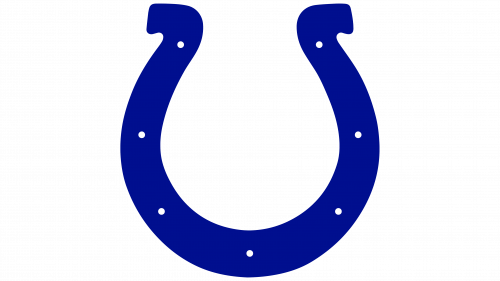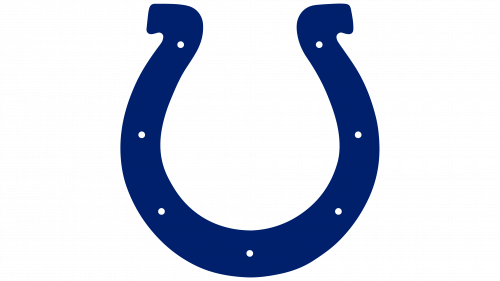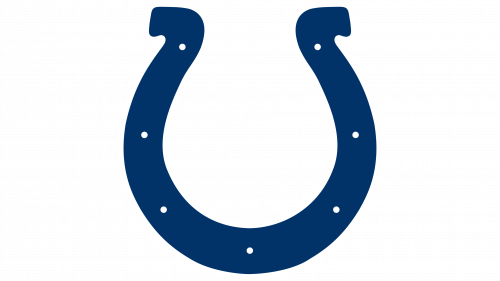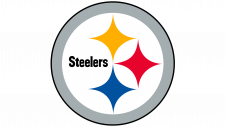Indianapolis Colts Logo
The Indianapolis Colts, a professional American football team, hail from Indianapolis, Indiana. As members of the AFC South division within the NFL, their history stretches back to 1953, originating in Baltimore. With a rich legacy, they boast two Super Bowl titles. Renowned for its iconic horseshoe logo, the team has seen periods of dominance, especially during the Peyton Manning era. Their home games come alive at Lucas Oil Stadium, an architectural marvel in downtown Indianapolis. While they’ve seen ups and downs, the Colts remain steadfast, showcasing grit, talent, and a passionate fanbase.
Meaning and history
The Indianapolis Colts, tracing their roots back to 1953, started their journey in Baltimore, Maryland, as the Baltimore Colts. Born out of the remains of the Dallas Texans, they quickly became an integral part of the NFL landscape.
In their early years, under the guidance of iconic coach Weeb Ewbank and the brilliance of quarterback Johnny Unitas, the Colts clinched the NFL Championship in 1958 and 1959. The 1958 victory, often dubbed the “Greatest Game Ever Played,” was a sudden-death overtime win against the New York Giants, helping propel the NFL to its current prominence.
In 1984, after a series of disputes between the team’s owner Robert Irsay and the city of Baltimore over stadium facilities, the franchise made a controversial move to Indianapolis, adopting the name “Indianapolis Colts”.
With this new chapter, the Colts had varying success. The most transformative period for the franchise began in 1998 with the drafting of quarterback Peyton Manning. His arrival heralded an era of prosperity. Alongside coach Tony Dungy, Manning led the team to its zenith. In 2006, the Colts defeated the Chicago Bears in Super Bowl XLI, giving Indianapolis its first Lombardi Trophy.
Post-Manning, the Colts underwent a brief period of reconstruction. However, fortune smiled upon them in the 2012 NFL Draft when they secured another generational talent, quarterback Andrew Luck. Though Luck’s career was marred by injuries, he showcased tremendous potential and led the team to multiple playoff appearances.
Lucas Oil Stadium, inaugurated in 2008 in downtown Indianapolis, has been the team’s fortress, known for its retractable roof and iconic city skyline views.
Through ups and downs, the Colts have established themselves as an indomitable spirit in the NFL, fueled by talent, resilience, and a passionate fanbase. Their legacy, dotted with legendary players, crucial games, and enduring moments, stands as a testament to their place in football history.
1952
The emblem from that era alludes to the team’s original moniker, the Dallas Texans. This insignia showcases the words “Dallas Texans” set against a deep blue square backdrop. There’s a noticeable size variation in the typography, lending a sense of movement. This dynamism is further enhanced by an illustration of a footballer, who, while sprinting with the ball, uses a straight-arm move. With his other arm, he gestures a “Beware!” sign. The team’s name, the depicted athlete, his attire, and even the ground segment below are all rendered in a vibrant gold hue. This golden representation stands out brilliantly against the blue.
1953 – 1960
Following the dissolution of the previous squad and the inception of the renewed team, there emerged a radically reimagined emblem. This insignia displays a cerulean bronco, mid-buck, gripping a blue football striped twice, soaring past a goalpost. A dislodged helmet, symbolizing the players’ fierce tenacity and resolve, is also depicted.
There is a white rectangular mark on the animal’s skull, serving as an emblem of good luck and triumph. Mirroring this hue is the creature’s hoof. While the majority of components bask in various shades of blue, the helmet stands out in a muted gray tone. The brand identifier, “BALTIMORE COLTS,” is presented in a silvery-gray with a defining blue outline. These words are distinctively placed – the former crowns the emblem’s top periphery, while the latter anchors the bottom. The goalposts, broad in their stance, are firmly entrenched, appearing as though rooted to the “earth” below.
1961 – 1978
This rendition represents a refined transformation of the earlier logo’s blueprint. The creators chose to omit certain non-essential elements like the goalposts, the terrain beneath them, and the team’s moniker, which previously dominated a significant portion of the emblem’s expanse. The focus is now solely on the soaring horse, set against a pristine white canvas. The football has undergone a change as well, morphing into a white shade encircled by a blue contour. Adorning the helmet is a deep blue horseshoe symbol. The previous grey shade has been dispensed with, making room for an enlarged depiction of the majestic creature, enhancing its prominence in the overall visual composition.
1979 – 1983
This emblem serves as the foundational touchstone for subsequent designs that will mark the team’s identity over consecutive years. Centerstage is a horseshoe, reminiscent of earlier times when it adorned a horse’s protective headgear. The current rendition, however, offers a more refined artistry: its form is sleeker compared to its original depiction, and it shimmers in a subtle shade of sky blue. Dotting the horseshoe are seven petite white indentations. The design architects contend that this chosen palette resonates deeply with values such as fortitude, relentless dedication, integrity, robust energy, captivating allure, and unparalleled brilliance. Through this logo, the team’s ethos and vision shine through.
1984 – 1996
Relocating to Indiana, the team carried with them the iconic Colt emblem that originated in Baltimore. The signature cerulean horseshoe, synonymous with the Baltimore era, was preserved. The Indianapolis Colts’ insignia is now synonymous with unyielding resilience, mirroring the spirit of a beast in its relentless pursuit of victory. The primary deviation is a subtle deepening of the hue, giving it a richer shade. All other design elements, from the number of perforations to the dimensions and contour, have been maintained, ensuring the logo remains a testament to the team’s enduring legacy and unwavering ambition.
1997 – 2001
The emblem representing the Indianapolis Colts prominently features a deep blue horseshoe, gracefully curved into a U formation, adorned with seven distinct nail imprints. This specific design traces its origins to the team’s days in Baltimore, remaining unchanged until 1983. Over the span of multiple decades, the Colts have experimented with and fine-tuned the intensity and shade of the blue in their symbol. This commitment to evolution, while respecting historical roots, mirrors the team’s journey – honoring the past, yet continuously seeking refinement and modernization, embodying both tradition and progress in their iconic representation.
2002 – 2003
In subsequent iterations, a rich navy hue was introduced, gaining prominence after the 2002 revamp. During this era, the Indianapolis Colts’ emblem experienced subtle transitions, predominantly in its color palette. Aside from these nuances, the emblem retained its foundational design: a sizable horseshoe punctuated with seven distinct openings against a pristine white backdrop. The primary motif’s color deepened, evolving into a standout shade of blue. As has always been its essence, the logo of the Indianapolis Colts symbolizes unwavering resolve and an undying commitment to triumph, echoing the team’s enduring spirit and quest for excellence.
2004 – Today
The signature symbol for the Indianapolis Colts is encapsulated by a deep azure horseshoe, masterfully shaped into a U silhouette, embellished with seven distinct nail imprints. This very design has historic ties, being the emblematic representation of the team during their Baltimore tenure, steadfast until 1983. As the years unfolded, the Colts, in their quest for perfection, revisited and subtly altered the depth and shade of the blue within this iconic design. This continuous evolution underlines the franchise’s commitment to both honoring a storied past and embracing an ever-changing future, embodying a blend of tradition and adaptability over the eras.
